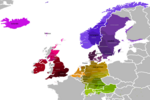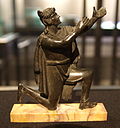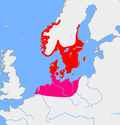transcription delimiters. The Germanic umlaut (sometimes called i-umlaut or i-mutation) is a type of linguistic umlaut in which a back vowel changes to... 52 KB (5,283 words) - 23:04, 25 March 2024 |
 | vowels (for example [a], [ɔ], and [ʊ] as [ɛ], [œ], and [ʏ]). (The term Germanic umlaut is also used for the underlying historical sound shift process.) In... 18 KB (2,075 words) - 23:04, 6 April 2024 |
with the study of Germanic languages, as umlaut had occurred prominently in many of their linguistic histories (see Germanic umlaut). While the common... 5 KB (592 words) - 08:29, 24 October 2023 |
umlaut triggered by a following high front vowel; in particular: Germanic umlaut, a prominent instance of i-mutation in the history of the Germanic languages... 2 KB (237 words) - 12:53, 1 April 2024 |
 | eläinkö "animal?" (interrogative) vs. eläinkoe "animal test" (cf. Germanic umlaut). If the character ö is unavailable, o is substituted and context is... 11 KB (1,156 words) - 07:43, 3 March 2024 |
 | [ɛː]) or Umlaut-A. Referring to the glyph as A-Umlaut is an uncommon practice, and would be ambiguous, as that term also refers to Germanic a-mutation... 8 KB (884 words) - 14:08, 19 April 2024 |
a-mutation is something of a misnomer. It has also been called "a-umlaut", "a/o-umlaut", "velar umlaut" and, formerly, "Brechung." (This last was Grimm's term,... 12 KB (1,525 words) - 05:00, 27 April 2024 |
law Holtzmann's law Sievers' law Verner's law Kluge's law Germanic a-mutation Germanic umlaut (all of the early languages except for Gothic) Great Vowel... 922 bytes (121 words) - 23:29, 24 November 2022 |
This happened, for example, in all of the West Germanic languages besides Old High German, where umlaut produced stem alternations in Class III weak verbs... 29 KB (2,932 words) - 16:56, 19 April 2024 |
The -j- produced umlaut of the stem vowel in languages other than Gothic. The -j- caused West Germanic gemination in the West Germanic languages in short-stem... 60 KB (5,117 words) - 07:44, 14 March 2024 |
formally distinct from phenomena like the Germanic umlaut, a form of vowel mutation used in plural forms in Germanic languages. There have been a variety of... 18 KB (1,128 words) - 18:38, 11 November 2023 |
A-umlaut may refer to: Ä, the letter A with an umlaut Germanic a-mutation, a historic sound change in Northwest Germanic languages Å This disambiguation... 169 bytes (56 words) - 13:55, 27 December 2019 |
 | Proto-Norse language (redirect from Proto-North Germanic) Proto-North Germanic) was an Indo-European language spoken in Scandinavia that is thought to have evolved as a northern dialect of Proto-Germanic in the first... 22 KB (2,296 words) - 17:27, 17 April 2024 |
language. The term "umlaut" is found especially in the Germanic languages (see Germanic umlaut). In some other languages, other terms are used instead... 2 KB (281 words) - 04:05, 16 August 2022 |
often involves vowels. Indo-European ablaut (English sing-sang) and Germanic umlaut (goose-geese), mentioned above, are well attested examples. Another... 24 KB (2,067 words) - 07:17, 24 March 2024 |
Phonological history of Old English (redirect from Palatal umlaut) occurred in most Germanic languages. Like most other Germanic languages, Old English underwent a process known as i-mutation or i-umlaut. This involved... 83 KB (8,846 words) - 00:19, 8 March 2024 |
 | Proto-Germanic *gebō 'gift' [ˈɣeβɔː] > Northwest Germanic *geƀu, whence North Germanic *gjavu > with u-umlaut *gjǫvu > ON gjǫf, West Germanic *gebu >... 57 KB (5,429 words) - 10:22, 25 March 2024 |
 | Dutch language (category Germanic languages) English, has not undergone the High German consonant shift, does not use Germanic umlaut as a grammatical marker, has largely abandoned the use of the subjunctive... 188 KB (18,773 words) - 22:25, 27 April 2024 |
English are generally considered irregularities, surviving results of Germanic umlaut. They include: man → men, woman → women louse → lice, mouse → mice... 1 KB (114 words) - 15:48, 29 November 2022 |
Öffa bills ("ö" is a Germanic umlaut that can be transcribed "oe") or job-creation bills were promissory notes created in 1932 by the German government... 3 KB (376 words) - 15:33, 20 October 2023 |
with an extra -j-, which causes umlaut in the present where possible. In West Germanic, it also causes the West Germanic gemination. The forms of class... 125 KB (12,200 words) - 18:20, 7 April 2024 |
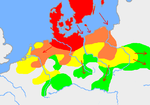 | Gothic language (category East Germanic languages) display a number of innovations shared by all Germanic languages attested later: lack of Germanic umlaut, lack of rhotacism. The language also preserved... 92 KB (9,687 words) - 23:28, 14 April 2024 |
 | -lier, -liest or -loker, -lokest. A few adjectives also displayed Germanic umlaut in their comparatives and superlatives, such as long, lenger. Other... 61 KB (5,406 words) - 12:00, 13 April 2024 |
Indo-European ablaut (category Germanic languages) clearly from other forms of gradation, which developed later, such as Germanic umlaut (man / men, goose / geese, long / length) or the results of modern... 28 KB (3,501 words) - 17:05, 1 April 2024 |
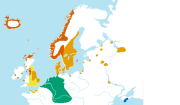 | Old Norse (category Articles containing Proto-Germanic-language text) unrounded vowels. Umlaut is phonemic and in many situations grammatically significant as a side effect of losing the Proto-Germanic morphological suffixes... 112 KB (8,802 words) - 17:08, 2 April 2024 |

